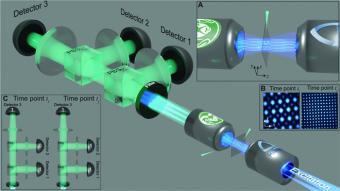Mines, CSU researchers combine classical, quantum optics for super-resolution imaging
Mines’ Jeff Squier and Colorado State's Randy Bartels were recently awarded $1.2M grant from the Chan Zuckerberg Initiative to pursue dynamic imaging work

Researchers at Colorado School of Mines and Colorado State University are on a quest to invent some of the world’s most powerful light microscopes – ones that can resolve large swaths of biological material in unimaginable detail.
The name of the game is super–resolution microscopy, which is any optical imaging technique that can resolve things smaller than half the wavelength of light. The discipline was the subject of the 2014 Nobel Prize in Chemistry, and scientists around the world are in a race to keep circumventing that diffraction limit to illuminate biologically important structures inside the body.
Jeff Squier, professor of physics, together with Randy Bartels, professor in the Department of Electrical Engineering at Colorado State University, have theorized a new super–resolution technique that uniquely fuses quantum and classical information derived from light to drastically improve imaging resolution.
The math and physics behind their idea, and why they think it will work, is detailed in the journal Intelligent Computing, a Science partner journal.
“While our paper represents a fusion of classical and quantum physics, it is fair to say it also represents a fusion of ideas from both Mines and CSU,” Squier said. “The fundamental ideas in the paper simply would not have manifested without the close collaboration that has been built up over the past several years by our groups.”
Squier has worked with CSU’s Bartels for several years. Their research partnership combines Bartels’ expertise in computation with Squier’s expertise in optical engineering, creating custom optics for their shared goals.
Their new computational imaging method works by precisely counting the arrival of photons, or quantum particles of light, emitted from a biological sample. The photons are excited by laser pulses, and by counting them one by one with detectors, a set of quantum and classical images emerge. The researchers then apply an algorithm to produce images that resolve the details of small structures, like cells, over large regions.
“Right now, people can do very high-resolution optical imaging, but it’s kind of like flying over the Rocky Mountains and being able to see all the trees, but not the fine details of the trees,” explained Bartels. Other super–resolution techniques exist that allow someone to zoom way in, say, on an individual leaf, he continued. But to look in fine detail across an entire forest is what Bartels and the team are going for.
“The idea here is to illuminate a large region of many cells, at high resolution, high speed, and across a high volume,” Bartels said.
The researchers will not need to wait to test the hypotheses of the paper, either.
Squier and Bartels were recently awarded a $1.2 million Dynamic Imaging Grant from the Chan Zuckerberg Initiative, which will allow them to build the requisite electronics and light detectors that are fast enough to capture and count single photons as described in their paper.
The grant will also support graduate students and other researchers to keep investigating the idea of classical and quantum-based super-resolution. The grant team’s principal investigators are Bartels, Squier and Ali Pezeshki, professor of electrical and computer engineering at CSU.




